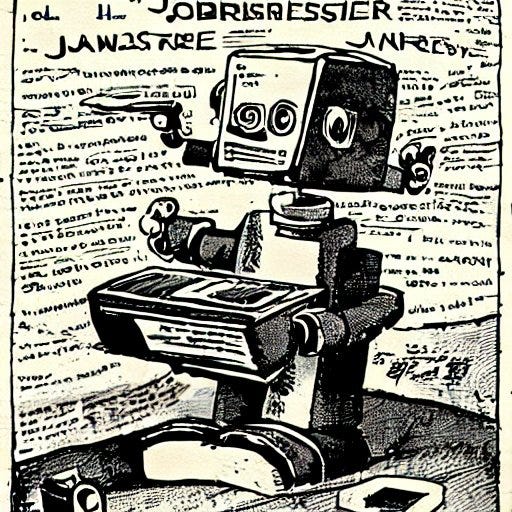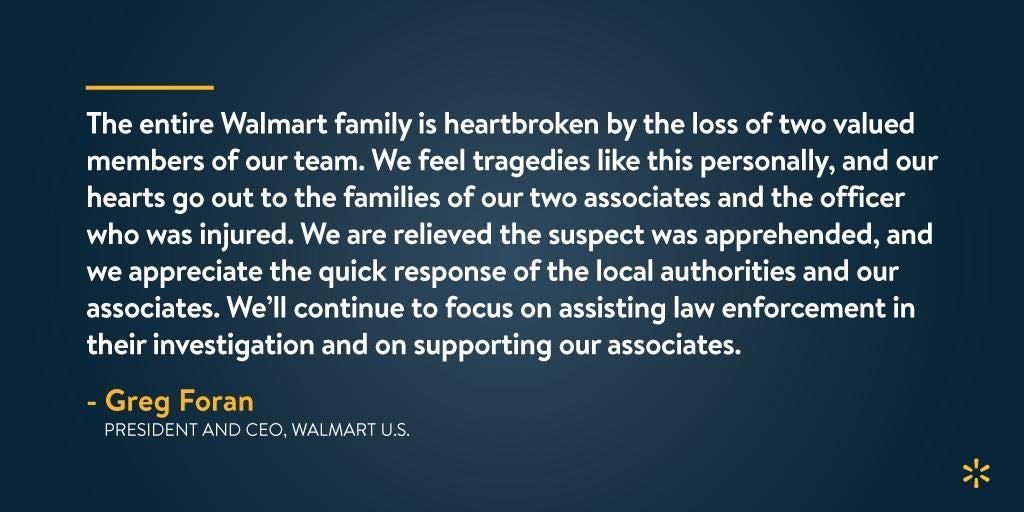...and these people have names.
Behind every good job, bad job, and job loss, there is a human being.

As usual it’s sometime Monday, and so it’s time for this week’s look at the employment environment as well as the world built around it! This week On the Job, we spotlight the undervalued human touch in everything we love and hate.
Once more I am AJ Freeman, and “This Was a Real Job.”
This Week in Work: In Good Company
Last week On the Job, we discussed the automation of customer service jobs and its eventual inevitability in the regular “Maybe Update Your Resume” segment…after all, in our modern world with its sacrosanct commitment to more faster cheaper, why would a job creator part with precious profits to pay a human being when the same job could be done—at least pretty well—with costless labor?
I’ve never been noted for my mathleticism, but the numbers add up easy for me.
Anyway, in the piece (or reading this publication in general), it could be easy to get the impression that I have some fundamental disdain for corporations or the processes they make possible, and that’s just not true. I happen to enjoy things like tomatoes in winter, solar panels, and the Internet, each representing large-scale collaborative processes that require astounding levels of coordination.
I just don’t always enjoy what corporation became by the time I was born.
You see, once upon a time a corporation (from the Latin “corporare,” “to unify into a single body”) was a mechanism by which a group of investors pooled together financing to achieve a specific goal in a defined time period: we the undersigned pledge to fund the production of 5 million thingies over the following 10 years.
At the end of the production period, it was safely dissolved (at least that’s what was supposed to happen in the manual).
Now, there’s certainly room to debate whether this arrangement allowed for efficient long-term planning, but I suppose that also calls into question what exactly long-term is…after all, as I quoted from Professor Richard Dawkins’ recent post exploring the concept of value, “the graph of available of good things is not a convenient straight line.”
Maybe regularly starting from square one has its merits…it’s the reason that societies around our world have largely decided, for better or worse, to try shaking up the direction of public life every few years like clockwork.

Whatever your feelings on the original structure of corporations, it’s impossible to deny that a lot has changed…after all, they started out as mere legal constructs and today, for legal purposes, are people, just regular people with feelings that impact material conditions for entire populations, effective ownership over massive regions, and as much access to the electoral process as money can buy.
With all that having been typed, there are still some larger companies at least making some attempt to fulfill the basics of the contract. In a time where actual innovation in the form of new and exciting thingies has been widely supplanted by more and more imaginative ways of extracting fees from some ideal infinite consumer, it’s important to keep in mind that some companies still produce.
It was my recent experience with PAX Labs that highlighted this endangered truth in practice.
First, a bit of background: The Pax 3 is not only an essential office supply in these lines of work, but probably the nicest single item I own.
I’ve never owned a car, I can’t afford one of those sweet Vitamix blenders and I’m typing these 3,000 words on a tablet because I’ve needed a new laptop for a while, but the $250 I spent on that device a few years ago has gotten me—for once—what is very likely the finest product of its type. It’s more than paid for itself.
Like, let’s understand here…”two hundred and fifty USD” doesn’t mean the same thing to everyone. Sure, over 50% of workers in the US couldn’t even come up with 1,000 USD at the same time in an emergency, but hey, maybe you’re in the other half. What I’m trying to make very clear to you here is that I really kinda had to stretch out to get the Pax 3 into my everyday life…but one lucky day I did.
So hopefully I was just able to put you in the mental space where losing such a hard-earned win could come as a pretty big blow to your day. That’s right, one day last week my treasured device unexpectedly stopped working, blinking one of those bone-chilling light patterns where you just know something is very wrong with your favorite toy.
With a product from most companies—including many of the biggest—that would have meant entering into some long, fruitless cycle of phone calls and emails, demands for long-trashed receipts and original boxes from half a decade ago. Not so with PAX Labs and the ironclad 10-year warranty they provide.
Nope, after just a few short messages and a short video demonstration of the issue at hand, the representative on the other end was able to confirm the shipment of a new device, which arrived at my address in the US today.
I do not expect the same level of personal attention from a chatbot.
For these reasons and more, when the last helpful human representative is replaced with an indifferent chatbot by demanding shareholders I will think fondly of PAX Labs and their commitment to not only engineering a fantastic product in the first place, but in standing behind it long-term.
One can easily imagine such a company mapping onto the original corporate structure in a way you couldn’t really imagine with, say, Apple.
The Pax 3 is, in order of importance, practical, effective, well-constructed, portable, lightweight, and attractive. Describing it honestly kinda sounds like I’m bullshitting you, but as I mentioned I just have a sardonic writing cadence. I didn’t get paid to say any of this—I’ll even send you this month’s bank statement to prove it if you want—but if they’d like to pay me to say it again that’s fine.
Maybe Update Your Resume: Journalist?
The biggest name in on The Internet has renewed an already vigorous surge into the world of AI with its new curation tool. Known on the Four-Color Campus as “Google Genesis,” the tool has been pitched to leading outlets including the New York Times, Washington Post, and the NewsCorp conglomerate.
Of course, it is fair to say that a large percentage of today’s public outreach and communication could certainly be handled by an AI content generator. Standard happenings in the US market such as baseball box scores and mass shootings could be easily automated…just feed in the relevant numbers and locations and watch a flavor-free Reuters-style report pop out in 30 seconds or less.
On the other hand, the advent of AI journalism is also another nail in the coffin of human participation in news curation. Just as the ongoing (and inevitable) collapse of print media has removed thousands of writers from the industry, AI tools will vastly reduce the headcount in newsrooms nationwide. Only the highest-profile heads will talk on TV, with obvious streamlining effects.
It also invites consideration of what a media reality entirely generated by customized AI-generated content from the New York Times, Washington Post, and the NewsCorp conglomerate looks like. What happens when AI-generated journalists cite each other’s citations? Who do we sue for the first “hallucination” that results in tangible damage? Imagine if Fox News starts hallucinating.
In any event, we may not have to imagine much longer…the big story this week is the same as it has been since this publication’s debut: the most resource-rich organizations in our world are working to ensure that costless labor has come again, stay tuned for ongoing developments in this quickly evolving situation.
Cannot Be Unseen: An MSRP on Labor

If you’ve been reading all this over the past months you’ve noticed that companies just can’t wait to announce their entry into the AI space…who could forget Wendys’ promise of AI drive-thrus and subterranean fry delivery later this year?
It’s all very interesting, naturally…look at all the words I write about it weekly.
Still, I can’t help but notice that contained within all these excited announcements of AI technologies in the workplace is an inherent acknowledgement of the hard minimum street value for that job. Let’s use the famous Flippy as an example here:
As I mentioned a segment or two ago, all my SAT points came from the English half, not the part with math…still, this seems like something you can pull off with a calculator, and not even one of the nice ones they use at NASA.

Because everything is our modern world is a rental service of some kind, Flippy can be brought into your burger joint “starting at 3,000 USD per month,” giving our robot arm a salary of $36k/yr. This gives Flippy, who does admittedly power through the restaurant’s full 70-hour work week, an hourly wage of $9.89010989011 (which must be a fun fact for anyone making less than that).
Let’s also assume that the device, like the best McDonald’s ice cream machine on the planet, never needs any maintenance of any kind.
This logically means that by purchasing Flippy for their restaurant, even disregarding antiquated concepts such as livable wages, staff morale, or employee turnover, a restaurant has acknowledged that the simple act of being present in front of a grill is worth just under $10 per hour of operation.
Now, do you want that burger topped with various sliced vegetables? How about wrapped in paper or placed on a plate? Then you apparently make premium burgers, and will have to retain a staff with these non-automated skills as well.
As we discussed last week, the concept of value is tricky to nail down…but it seems like automation can demonstrate concrete market values on human labor.
Hope Spot: Naming Names
As I mentioned a few Hope Spots ago, sometimes hope is about as bitter as it is sweet, and that’s definitely the flavor of this week’s entry.
Meteorologist Guy Walton, a Weather Channel 30-year veteran this summer has suggested naming the deadly heat waves after top polluters in our world instead of the “mythical beasts” that have descended upon Europe in recent weeks.
In his view, headlines such as “Nestlé Heat Wave Kills Thousands Across Europe” and “Dangerous Conditions From Ongoing Coca-Cola Heat Wave Cancels Upcoming Global Climate Conference in Dubai” will go a long way toward organizing a fuller public understanding of the situation we face. If you’re asking me, which I suppose you have by scrolling this far, there’s sense in what he says.
Monsters like the Cerberus are fiction, the engaging work of an interested observer. The monsters that knowingly poisoned our biosphere for profit are all too real. With documents at corporations such as Shell revealing that climate breakdown was elucidated internally for decades, our current climate chaos is the appalling work of the most uniquely cynical minds in human history.
There’s even plenty of space for his initiative to flourish, as there is currently no international protocol around the naming of heat waves at this time so his idea is as established as any other. I don’t have enough money to speak very authoritatively to the matter, but if we’re taking a vote Guy Walton has mine here.
Sure, it’s just one rogue weatherman in a (rising) sea of calm reporting about the most extraordinary environmental concerns to face our species in its modern form…but hey, folks on TV are starting to say what we the untelevised are thinking.
Retired or not, the man is doing his job…sometimes that’s the best we can do.












